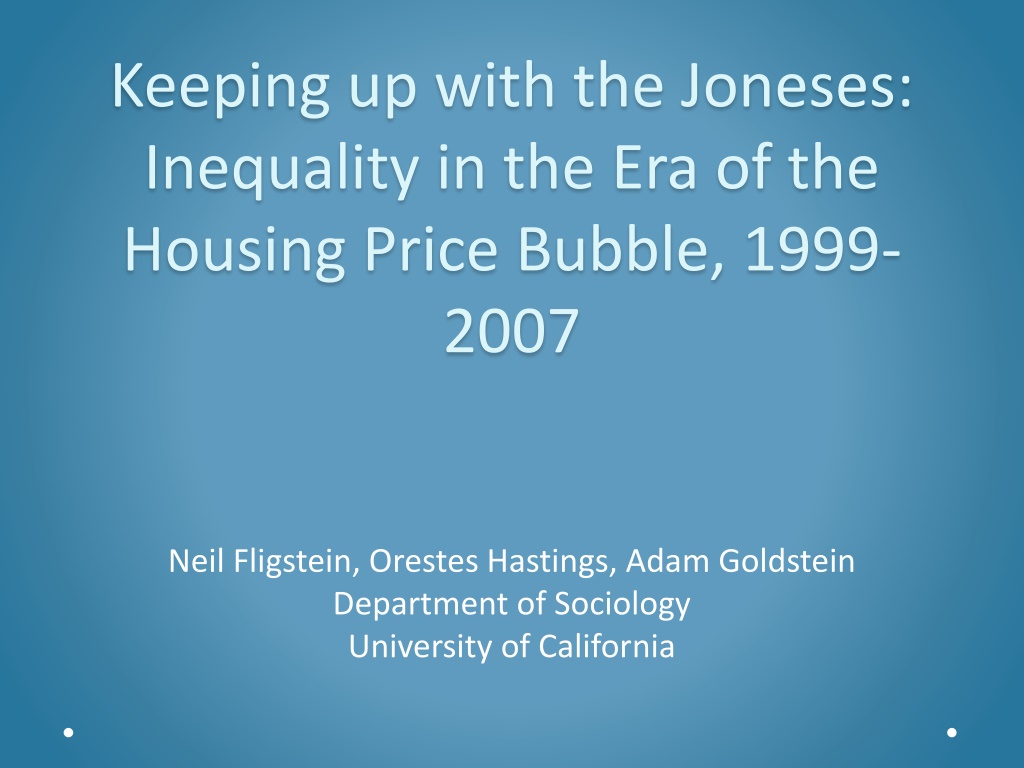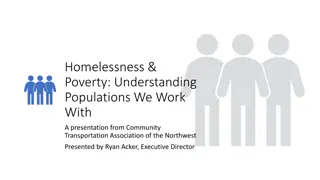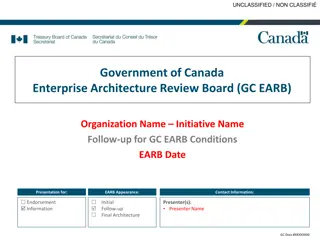
Understanding Household Responses to Rising House Prices
Exploring the impact of income inequality on households' ability to maintain their status through housing upgrades amid rising prices from 1999 to 2007. Upper-income households upgraded, while lower-income households faced challenges in the housing market.
Download Presentation

Please find below an Image/Link to download the presentation.
The content on the website is provided AS IS for your information and personal use only. It may not be sold, licensed, or shared on other websites without obtaining consent from the author. If you encounter any issues during the download, it is possible that the publisher has removed the file from their server.
You are allowed to download the files provided on this website for personal or commercial use, subject to the condition that they are used lawfully. All files are the property of their respective owners.
The content on the website is provided AS IS for your information and personal use only. It may not be sold, licensed, or shared on other websites without obtaining consent from the author.
E N D
Presentation Transcript
Keeping up with the Joneses: Inequality in the Era of the Housing Price Bubble, 1999- 2007 Neil Fligstein, Orestes Hastings, Adam Goldstein Department of Sociology University of California
Motivation Sociologists have conceptualized lifestyles as structured hierarchically where those in a lower social status seek to emulate those higher up This has become harder as income inequality as grown for two reasons: ----Those higher up, particularly in the top 10% of the income distribution have more money ----As a result, those at the top are able bid up the price of valued goods like housing and access to good schools for their children while those in lower groups have struggled to maintain their positions In this paper, we consider how households responded to the rapid rise of house prices from 1999-2007 We examine how inequality affected how households were or were not able to maintain their positions
Main Results We use the Panel Study of Income Dynamics, 1999-2007 to examine housing moves Overall, we provide evidence consistent with the idea that all groups responded to the status competition of rising house prices by trying hard to upgrade their housing As house prices rose, we show that upper income households (80-100% in the income distribution) upgraded their houses by relocating to more expensive zip codes and larger houses in their quest to maintain their status But those in the bottom 50% of the income distribution found it difficult to participate in the housing market at all and frequently moved to lower priced rentals When they did buy, rising prices pushed them to increase their share of expenditure on housing
The problem of lifestyle Elias and Bourdieu Status competition and emulating those at your level or just above Income, lifestyle, and status competition
Houses are the ultimate status symbol Home ownership has been the aspirational goal of the middle class in the U.S. since the 1920s Polls show that 85% of Americans in 1975 saw houses as necessary to have a good life , 87% in 1991, 89% in 2001, and 88% in 2008 Pew Research Center in a report on the state of middle class America find that middle class Americans regard their home as their most important asset and the anchor of their lifestyle (2008:33) Their size, quality, and location signal to others that one has (or has not) arrived
The problem of growing inequality More income and wealth inequality puts pressure of households to spend more for valued goods like houses (i.e. keeping up with the Joneses gets harder) This bids the price of those goods up Households who want to keep up must go farther into debt because things cost more If everyone is willing to go into debt, everyone will find themselves in the same relative position with more debt Households who have too little income will fall behind and not be able maintain their relative position
The house price bubble of 1999-2007 Offers us an opportunity to observe how households at various parts of the income distribution responded to higher house prices (and higher rental prices) in their areas Our theory suggests that households in areas with the most rapidly increasing house prices will particularly feel this pressure We use the Panel Study of Income Dynamics combined with geo-coded information on house prices to assess how this played out
Data Panel Study of Income Dynamics Waves: 1999-2011, 2001-2003, 2003-2005, 2005-2007 Household unit of analysis We have zip code level data and use Zillow to estimate how much house prices have increased in the zip code into which they have moved
Methods problems Theories of lifestyle assume that households are constantly adjusting their housing decisions based on their perception of their social status In practice, improving one s social status is only one reason why households might decide to stay or move Once a household has bought a house, they are less likely to move Most households, including renters, do not move every year
To understand if people move in response with pressures to improve their lifestyle We only analyze those who move in the PSID Households in each wave are categorized into one of four categories: owner to owner, non-owner to owner, owner to non-owner, non-owner to non-renter
Percent of income group who owned a home
Mean debt to income if home owner
Conclusion Home ownership increased across income groups even as home prices rose Home prices rose the most in the zip codes where the highest income groups lived Not surprisingly, people who bought homes in those income groups took on the most debt across all households But if we look only at households who owned homes, the lowest income households who managed to buy found themselves the deepest in debt Taken together, this suggests that middle and upper middle class people felt the need to go deep into debt in order to keep up with rising house prices driven by the highest income groups while lower income groups mostly were unable to participate in the housing bubble but if they did, they went deeply into debt
Conclusion Higher income households were the most likely to move from owning one home to another while lower income households most likely were moving as renters Middle income households show the highest rate of moving from being non-owners to owners suggesting that rising house prices were not keeping them from home ownership
Percentage of households who gave as reason to move, upgrade, downgrade, or other 70 60 50 40 Up Down 30 Other 20 10 0 p 1-50 p 51-80 p 81-100
In our paper We model the role of commuting zone income inequality on household purchases We show that in more unequal places, people both buy larger houses and take on higher expenditures on housing We also show that renters tend to move to smaller spaces and pay less money while new owners pay more money and buy larger houses
Inequality and Lifestyle Households during the housing bubble tended to buy larger houses and have higher housing expenditures even as house prices rose In places where there was high income inequality this was particularly pronounced Keeping up with the Jones cost more, but if households could, they were more than willing to do it
The bottom 40% of the income distribution tried to keep up but were faced with the most trying circumstances Renters often moved to reduce their housing expenditures and size of home The social pressure to keep up with the Jones meant that those who could willingly did, but for those lower in the income distribution, housing got downgraded






















